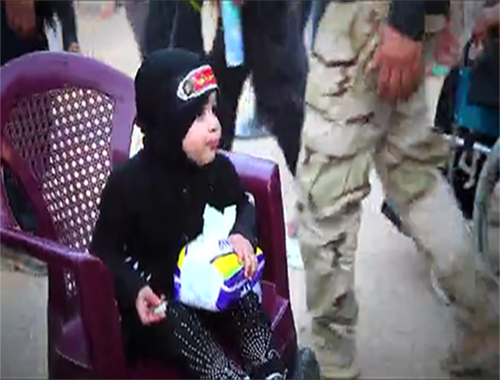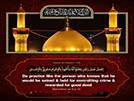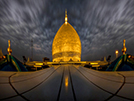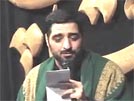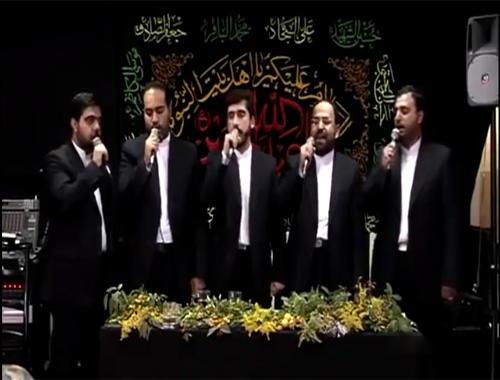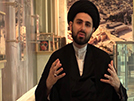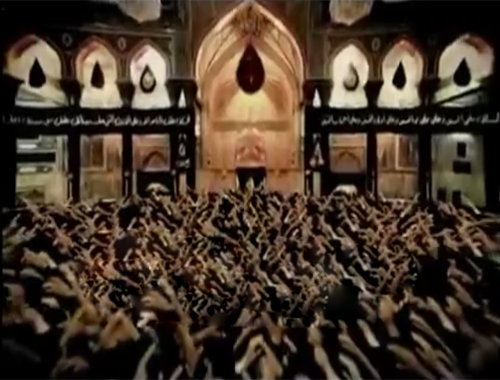Umrah
- Details
- Hits: 3068
Umrah
1- Pilgrims head for rendezvous (Mikat), Al-Shajara mosque or Al-Jahfah for example, for wearing ihram garment.
2- After that pilgrims go to the holy mosque for performing circumambulation or tawaf and its prayer.
3- Then endeavor between Safa and Marwah.
4- Shortening or clipping after the endeavor, here, acts of Umrah terminate. (There is no specified location for shortening hair and clipping nails).
2- After that pilgrims go to the holy mosque for performing circumambulation or tawaf and its prayer.
3- Then endeavor between Safa and Marwah.
4- Shortening or clipping after the endeavor, here, acts of Umrah terminate. (There is no specified location for shortening hair and clipping nails).
________________________________________
Umrah (1)
1- Those that are staying twenty four kilometers far from Mecca and intend to attend Hajj season must achieve “Umrah” prior to Hajj rituals.
2- Acts of Umrah are as follows:
*Ihram (putting on pilgrim’s garment).
*Circumambulation.
*Prayer for circumambulation.
*Endeavor between Safa and Marwah.
*Shortening or clipping (2).
3- Time for achieving Umrah:
Umrah must be achieved from the first day of Shawwal lunar
month up to the noon of the ninth day of Thee Al-Hejja month.
________________________________________
1- Enjoyable: It means in the language getting the enjoyment by obtaining a pre- designated target, in this case it is a kind of Hajj and omrah. It was dubbed so due to the pilgrim’s right to have sexual intercourse with his wife after accomplishing Umrah acts prior to reputing ihram garment for Hajj rituals.
2- Shortening and clipping: In jurisprudence terms, they mean shortening a part of the hair or the mustache, or clipping one of the nails, and this is one of Hajj and omrah acts.
___________________________________________
If it happened that duration has elapsed, this means that time for Umrah has terminated, therefore, a pilgrim’s duty would alter.
4- Location for performing Umrah:
*Ihram: At one of the rendezvous: (1) for example, Al-Johfah or Al-Shajarah mosque.
*Circumambulation: At the holy mosque around the Kaaba.
*Prayer for the circumambulation: At the holy mosque, behind Abraham’s shrine.
*Endeavor: between Safa and Marwah (3) which is a covered passage at the present.
*Shortening and clipping: There is no specified location for them.
We shall talk about each one of those acts in detail later.
_______________________________________
1- Rendezvous (Mikat): It is the place designated for wearing ihram garment, it includes the following locations: Al-Shajarah mosque, Al-Johfah, Wadi Akik (That Al-Erik), Karn Al-Manazel and Yalamlam (Look at the picture at page 17).
2- Abraham’s shrine: It is a stone which Abraham (pbuh) put it under his feet while he was erecting Kaaba, his footprints are still on the stone up to day. It was preserved by putting it in a glassy cover near sacred Kaaba.
3- Safa and Marwah are names for two small mountains near the holy mosque, a significant portion of the two mountains was deducted from both mountains a couple of years ago, and a covered passage was built between Safa and Marwah.
___________________________________________
Ihram (The first act of Umrah).
Baqi
Those individuals that honored by visiting Prophet Muhammad’s shrine in Medina, and the graves of Imams (pbut) in Bakea prior to achieving Hajj rituals, must wear pilgrims’ garment at Al-Shajarah mosque that is located some kilometers far from Medina on their way to Mecca, but for those who head for Mecca from Jeddah city, they must wear ihram garment at Al-Johfah prior to their departure to the holy mosque.
Method of ihram (1):
*Men must take off all sewed clothes, even underwear clothes, and put on two pieces of garment, first one covers the back as a loincloth, and the second one covers the shoulders, after repeating the intention for Umrah they must say: “O God! We are at your service there is no partner with you”.
_____________________________________
1- Ayatollah Zanjani: Duties of ihram are five: Ritual purity- Ihram garment-
Ihram prayer- Intention- Repeating compliance to God’s invitation (Talbiah).
_____________________________________
As a precautionary measure, pilgrims should repeat the following (1):
“Boon and praise are from you (God), there is no partner with you, and we are at your service”.
*Ladies can wear sewing clothes, it is not compulsory for them to take off sewing clothes, and put on two pieces of garment as men do. Therefore, ladies repeat intention for performing omrah and compliance to God’s invitation.
Repeated intention is meant for Umrah, this act and following ones are for obedience to God’s decrees (2), it is not compulsory to repeat compliance in a loud manner, although it is desirable to do so.
__________________________________________
1- Ayatollah Bahjat: As a precautionary measure, pilgrims should repeat the second sentence.
Ayatollah Makarem Al-Shirazi: As a precautionary step, pilgrims should repeat the second sentence, and refrain from fifth compliance. Of course, repeating fifth compliance on the basis of precautionary measure is desirable, and would not affect the correctness of compliance (Talbiah) in any way.
2- Ayatollah Safi, Ayatollah Bahjat: An individual that is wearing ihram garment and repeated compliance (Talbiah) should intend to refrain from forbidden acts which include him.
Ayatollah Khaminaei: A pilgrim must not have intention to commit what causes invalidity of ihram.
________________________________________
A couple of issues:
1- Pilgrims’ clothes must be clean, pure and lawful.
2- Ladies must refrain from wearing silky clothes during ihram.
3- If it happened, during ihram, impurity touched a pilgrim’s body or his garment, as a precautionary step (1) he must purify his body and change his garment or purify them.
__________________________________________
1- Ayatollah Makarem Al-Shirazi: It is compulsory.
Ayatollah Safi: It is a desirable precautionary step.
Ayatollah Bahjat: If it happened that a pilgrim’s body got impure, it is not compulsory to purify it for ihram.
________________________________________
Circumambulation (Second act of Umrah).
Anyone wishes to perform Umrah acts, and heads for Mecca for this purpose, must intend to circumambulate around Kaaba in the holy mosque over seven stages.
Circumambulation (Tawaf) procedure:
1- A pilgrim must commence his circumambulation from the corner that includes the black stone (1) and terminates it at the same corner (2).
2- Kaaba must be parallel to the pilgrim’s left shoulder; therefore if he faced or retreated during circumambulation, his act would be incorrect.
3- A pilgrim must achieve his duty, as Muslims do, away of scrupulosity, he must start in front of the black stone, and there is no necessity to halt in front of the black stone at the end of each stage of the seven stages.
_________________________________________
1- The black stone is an oval one with black color; it is being located at the eastern corner of Kaaba’s wall, and it is higher one and half meter from the surface of the holy mosque.
2- Today, there is a black line on the ground in front of the black stone to the end of the holy mosque courtyard, pilgrims can start and end their circumambulation once they get there.
3- A pilgrim must circumambulate around “Ishmael place” (1), he does not have to enter that place during circumambulation.
_____________________________________________
1- Ishmael places: It is a space between Kaaba and a half circulated wall with ten meters width, it stretches from northern corner to the western corner for sacred Kaaba. Whenever rain pours on Kaaba, water fills from the gutter to that space.
This place is the burial of Ishmael (pbuh), his mother Hajar and a number of Prophets (pbut).
_________________________________________________
4- Limits of circumambulation around Kaaba: The space between Kaaba and Abraham’s shrine, thirteen meters approximately, therefore the distance near Ishmael place minimizes to four meters only(1).
5- If an individual could not circumambulate at that space due to illness, senility or heavy congestion, he is permitted to perform circumambulation outside that space and no objection for that.
6- A pilgrim must be pure and performing ablution and no ritual purity is recommended during circumambulation, his body and clothes must be purred as in prayer.
____________________________________________________
1- Ayatollah Khaminaei: There is no limitation for circumambulation.
Ayatollah Fadel: Apparently, limits of circumambulation stretch to thirteen meters near Ishmael place, but the desirable precautionary step is to circumambulate within four meters in that area.
Ayatollah Makarem Al-Shirazi: It is desirable to perform circumambulation at those limits, although it is not compulsory.
Ayatollah Al-Zanjani: Circumambulation must carried out between Kaaba and Abraham’s shrine which is around twelve meters, but from Ishmael place circumambulation would be accounted from outside the place and not from Kaaba’s wall.
___________________________________________
Circumambulation prayer (Third act of Umrah).
After performing circumambulation, a pilgrim must achieve prayer consisting of two knees with the intention of Tawaf prayer.
*Tawaf prayer procedure: It is exactly as Morning Prayer, a pilgrim has the choice either to read Al-Hamd chapter and the other chapter loudly or in a whisper.
*Time of circumambulation (Tawaf) prayer: After performing Tawaf and prior to endeavor between Safa and Marwah.
*Place of Tawaf prayer: In the holy mosque, at Abraham’s shrine, as a precautionary step (1) it is desirable to perform it behind Abraham’s shrine, in a way that the shrine be located between the pilgrim and sacred Kaaba. It is desirable for the pilgrim to get close to the shrine as much as it is possible (on condition that he does not irritate other pilgrims). If a pilgrim was not able of performing his prayer behind the shrine due to heavy congestion, he could do it on the sides of the shrine but trying to get close as much as he could (2).
_________________________________________________
1- Grand Ayatollahs: Tabrizi, Sistani, Fadel and Zanjani: It is compulsory to perform prayer behind Abraham’s shrine.
Ayatollah Khaminaei: It would suffice if the customary points are located behind the shrine, even though they are far for some extend, therefore prayer could be performed there, although it is likely to perform prayer at any point of the holy mosque.
Ayatollah Tabrizi: In the case of difficulties in performing prayer behind Abraham’s shrine or close to it, a pilgrim must get further but trying his best to be close to it as much as he could.
Ayatollah Sistani: If a pilgrim was not able to perform his prayer behind Abraham’s shrine, as a precautionary measure and compulsory at the same time, to do it at right and left sides of the shrine, but behind it.
_____________________________________________
1- All adults and mature individuals must learn performing prayer at its best way,
In order to accomplish the divine duties as have been decreed by almighty God, in particular those who intend to attend omrah or Hajj season. They must learn how to pray in the proper way in order to perform all their prayers including Tawaf prayer correctly.
2- As a precautionary and compulsory step, Tawaf prayer must be performed after circumambulation directly, in order to stop any confusion, in addition that some people might say there is interval between circumambulation and its prayer.
3- Desirable prayer could be performed at any spot of the holy mosque.
Abraham’s shrine and the place for performing Tawaf
For performing Tawaf prayer a pilgrim should stop at a place known as behind the shrine.
________________________________________
Endeavor (Saia) between Safa and Marwah(Forth act of Umrah).
After performing Tawaf prayer, a pilgrim must perform endeavor between Safa and Marwah mountains exactly in the covered passage near the holy mosque over seven stages.
1- Endeavor commences from Safa Mountain and terminates at Marwah Mountain.
2- The distance from Safa to Marwah is calculated as one stage, and vice versa, therefore, the seventh stage (1) ends at Marwah Mountain.
3- A pilgrim can sit to have some rest between two mountains, even during endeavor, he must resume his endeavor from the point he halted.
4- It is not compulsory for the pilgrim to perform ablution or be ritually pure to achieve endeavor (Saia), although it is preferable to be pure.
5- Endeavor at the second floor of the passage is prohibited due to its height from two mountains.
____________________________________________
1- One stage: It means in the language the end of the endeavor at the designated target. At this place, it means one time Tawaf around Kaaba and one stage of Saia between Safa and Marwah and vice versa.
________________________________________
Two portraits
Saia between Safa and Marwah mountains
Shortening and clipping (Last act of Umrah).
After achieving Saia (Endeavor), a pilgrim has the choice in shortening either his hair or mustache or clipping one of his nails, therefore his Umrah’s acts terminate here.
Having done that, what was forbidden for a pilgrim would be lawful, he could take off ihram garments.
Time of shortening and clipping: After performing shortening or clipping, although it is not compulsory to do so right after Saia, but as long as a pilgrim did not perform shortening or clipping he would be subjected to forbidden acts for pilgrims.
Place of shortening and clipping: There is no specified place for that, but it is common that pilgrims do shortening and clipping right after Saia near Marwah mountain.
A pilgrim that did not shorten or clip yet, could not do that act for another pilgrim.
Umrah (1)
1- Those that are staying twenty four kilometers far from Mecca and intend to attend Hajj season must achieve “Umrah” prior to Hajj rituals.
2- Acts of Umrah are as follows:
*Ihram (putting on pilgrim’s garment).
*Circumambulation.
*Prayer for circumambulation.
*Endeavor between Safa and Marwah.
*Shortening or clipping (2).
3- Time for achieving Umrah:
Umrah must be achieved from the first day of Shawwal lunar
month up to the noon of the ninth day of Thee Al-Hejja month.
________________________________________
1- Enjoyable: It means in the language getting the enjoyment by obtaining a pre- designated target, in this case it is a kind of Hajj and omrah. It was dubbed so due to the pilgrim’s right to have sexual intercourse with his wife after accomplishing Umrah acts prior to reputing ihram garment for Hajj rituals.
2- Shortening and clipping: In jurisprudence terms, they mean shortening a part of the hair or the mustache, or clipping one of the nails, and this is one of Hajj and omrah acts.
___________________________________________
If it happened that duration has elapsed, this means that time for Umrah has terminated, therefore, a pilgrim’s duty would alter.
4- Location for performing Umrah:
*Ihram: At one of the rendezvous: (1) for example, Al-Johfah or Al-Shajarah mosque.
*Circumambulation: At the holy mosque around the Kaaba.
*Prayer for the circumambulation: At the holy mosque, behind Abraham’s shrine.
*Endeavor: between Safa and Marwah (3) which is a covered passage at the present.
*Shortening and clipping: There is no specified location for them.
We shall talk about each one of those acts in detail later.
_______________________________________
1- Rendezvous (Mikat): It is the place designated for wearing ihram garment, it includes the following locations: Al-Shajarah mosque, Al-Johfah, Wadi Akik (That Al-Erik), Karn Al-Manazel and Yalamlam (Look at the picture at page 17).
2- Abraham’s shrine: It is a stone which Abraham (pbuh) put it under his feet while he was erecting Kaaba, his footprints are still on the stone up to day. It was preserved by putting it in a glassy cover near sacred Kaaba.
3- Safa and Marwah are names for two small mountains near the holy mosque, a significant portion of the two mountains was deducted from both mountains a couple of years ago, and a covered passage was built between Safa and Marwah.
___________________________________________
Ihram (The first act of Umrah).
Baqi
Those individuals that honored by visiting Prophet Muhammad’s shrine in Medina, and the graves of Imams (pbut) in Bakea prior to achieving Hajj rituals, must wear pilgrims’ garment at Al-Shajarah mosque that is located some kilometers far from Medina on their way to Mecca, but for those who head for Mecca from Jeddah city, they must wear ihram garment at Al-Johfah prior to their departure to the holy mosque.
Method of ihram (1):
*Men must take off all sewed clothes, even underwear clothes, and put on two pieces of garment, first one covers the back as a loincloth, and the second one covers the shoulders, after repeating the intention for Umrah they must say: “O God! We are at your service there is no partner with you”.
_____________________________________
1- Ayatollah Zanjani: Duties of ihram are five: Ritual purity- Ihram garment-
Ihram prayer- Intention- Repeating compliance to God’s invitation (Talbiah).
_____________________________________
As a precautionary measure, pilgrims should repeat the following (1):
“Boon and praise are from you (God), there is no partner with you, and we are at your service”.
*Ladies can wear sewing clothes, it is not compulsory for them to take off sewing clothes, and put on two pieces of garment as men do. Therefore, ladies repeat intention for performing omrah and compliance to God’s invitation.
Repeated intention is meant for Umrah, this act and following ones are for obedience to God’s decrees (2), it is not compulsory to repeat compliance in a loud manner, although it is desirable to do so.
__________________________________________
1- Ayatollah Bahjat: As a precautionary measure, pilgrims should repeat the second sentence.
Ayatollah Makarem Al-Shirazi: As a precautionary step, pilgrims should repeat the second sentence, and refrain from fifth compliance. Of course, repeating fifth compliance on the basis of precautionary measure is desirable, and would not affect the correctness of compliance (Talbiah) in any way.
2- Ayatollah Safi, Ayatollah Bahjat: An individual that is wearing ihram garment and repeated compliance (Talbiah) should intend to refrain from forbidden acts which include him.
Ayatollah Khaminaei: A pilgrim must not have intention to commit what causes invalidity of ihram.
________________________________________
A couple of issues:
1- Pilgrims’ clothes must be clean, pure and lawful.
2- Ladies must refrain from wearing silky clothes during ihram.
3- If it happened, during ihram, impurity touched a pilgrim’s body or his garment, as a precautionary step (1) he must purify his body and change his garment or purify them.
__________________________________________
1- Ayatollah Makarem Al-Shirazi: It is compulsory.
Ayatollah Safi: It is a desirable precautionary step.
Ayatollah Bahjat: If it happened that a pilgrim’s body got impure, it is not compulsory to purify it for ihram.
________________________________________
Circumambulation (Second act of Umrah).
Anyone wishes to perform Umrah acts, and heads for Mecca for this purpose, must intend to circumambulate around Kaaba in the holy mosque over seven stages.
Circumambulation (Tawaf) procedure:
1- A pilgrim must commence his circumambulation from the corner that includes the black stone (1) and terminates it at the same corner (2).
2- Kaaba must be parallel to the pilgrim’s left shoulder; therefore if he faced or retreated during circumambulation, his act would be incorrect.
3- A pilgrim must achieve his duty, as Muslims do, away of scrupulosity, he must start in front of the black stone, and there is no necessity to halt in front of the black stone at the end of each stage of the seven stages.
_________________________________________
1- The black stone is an oval one with black color; it is being located at the eastern corner of Kaaba’s wall, and it is higher one and half meter from the surface of the holy mosque.
2- Today, there is a black line on the ground in front of the black stone to the end of the holy mosque courtyard, pilgrims can start and end their circumambulation once they get there.
3- A pilgrim must circumambulate around “Ishmael place” (1), he does not have to enter that place during circumambulation.
_____________________________________________
1- Ishmael places: It is a space between Kaaba and a half circulated wall with ten meters width, it stretches from northern corner to the western corner for sacred Kaaba. Whenever rain pours on Kaaba, water fills from the gutter to that space.
This place is the burial of Ishmael (pbuh), his mother Hajar and a number of Prophets (pbut).
_________________________________________________
4- Limits of circumambulation around Kaaba: The space between Kaaba and Abraham’s shrine, thirteen meters approximately, therefore the distance near Ishmael place minimizes to four meters only(1).
5- If an individual could not circumambulate at that space due to illness, senility or heavy congestion, he is permitted to perform circumambulation outside that space and no objection for that.
6- A pilgrim must be pure and performing ablution and no ritual purity is recommended during circumambulation, his body and clothes must be purred as in prayer.
____________________________________________________
1- Ayatollah Khaminaei: There is no limitation for circumambulation.
Ayatollah Fadel: Apparently, limits of circumambulation stretch to thirteen meters near Ishmael place, but the desirable precautionary step is to circumambulate within four meters in that area.
Ayatollah Makarem Al-Shirazi: It is desirable to perform circumambulation at those limits, although it is not compulsory.
Ayatollah Al-Zanjani: Circumambulation must carried out between Kaaba and Abraham’s shrine which is around twelve meters, but from Ishmael place circumambulation would be accounted from outside the place and not from Kaaba’s wall.
___________________________________________
Circumambulation prayer (Third act of Umrah).
After performing circumambulation, a pilgrim must achieve prayer consisting of two knees with the intention of Tawaf prayer.
*Tawaf prayer procedure: It is exactly as Morning Prayer, a pilgrim has the choice either to read Al-Hamd chapter and the other chapter loudly or in a whisper.
*Time of circumambulation (Tawaf) prayer: After performing Tawaf and prior to endeavor between Safa and Marwah.
*Place of Tawaf prayer: In the holy mosque, at Abraham’s shrine, as a precautionary step (1) it is desirable to perform it behind Abraham’s shrine, in a way that the shrine be located between the pilgrim and sacred Kaaba. It is desirable for the pilgrim to get close to the shrine as much as it is possible (on condition that he does not irritate other pilgrims). If a pilgrim was not able of performing his prayer behind the shrine due to heavy congestion, he could do it on the sides of the shrine but trying to get close as much as he could (2).
_________________________________________________
1- Grand Ayatollahs: Tabrizi, Sistani, Fadel and Zanjani: It is compulsory to perform prayer behind Abraham’s shrine.
Ayatollah Khaminaei: It would suffice if the customary points are located behind the shrine, even though they are far for some extend, therefore prayer could be performed there, although it is likely to perform prayer at any point of the holy mosque.
Ayatollah Tabrizi: In the case of difficulties in performing prayer behind Abraham’s shrine or close to it, a pilgrim must get further but trying his best to be close to it as much as he could.
Ayatollah Sistani: If a pilgrim was not able to perform his prayer behind Abraham’s shrine, as a precautionary measure and compulsory at the same time, to do it at right and left sides of the shrine, but behind it.
_____________________________________________
1- All adults and mature individuals must learn performing prayer at its best way,
In order to accomplish the divine duties as have been decreed by almighty God, in particular those who intend to attend omrah or Hajj season. They must learn how to pray in the proper way in order to perform all their prayers including Tawaf prayer correctly.
2- As a precautionary and compulsory step, Tawaf prayer must be performed after circumambulation directly, in order to stop any confusion, in addition that some people might say there is interval between circumambulation and its prayer.
3- Desirable prayer could be performed at any spot of the holy mosque.
Abraham’s shrine and the place for performing Tawaf
For performing Tawaf prayer a pilgrim should stop at a place known as behind the shrine.
________________________________________
Endeavor (Saia) between Safa and Marwah(Forth act of Umrah).
After performing Tawaf prayer, a pilgrim must perform endeavor between Safa and Marwah mountains exactly in the covered passage near the holy mosque over seven stages.
1- Endeavor commences from Safa Mountain and terminates at Marwah Mountain.
2- The distance from Safa to Marwah is calculated as one stage, and vice versa, therefore, the seventh stage (1) ends at Marwah Mountain.
3- A pilgrim can sit to have some rest between two mountains, even during endeavor, he must resume his endeavor from the point he halted.
4- It is not compulsory for the pilgrim to perform ablution or be ritually pure to achieve endeavor (Saia), although it is preferable to be pure.
5- Endeavor at the second floor of the passage is prohibited due to its height from two mountains.
____________________________________________
1- One stage: It means in the language the end of the endeavor at the designated target. At this place, it means one time Tawaf around Kaaba and one stage of Saia between Safa and Marwah and vice versa.
________________________________________
Two portraits
Saia between Safa and Marwah mountains
Shortening and clipping (Last act of Umrah).
After achieving Saia (Endeavor), a pilgrim has the choice in shortening either his hair or mustache or clipping one of his nails, therefore his Umrah’s acts terminate here.
Having done that, what was forbidden for a pilgrim would be lawful, he could take off ihram garments.
Time of shortening and clipping: After performing shortening or clipping, although it is not compulsory to do so right after Saia, but as long as a pilgrim did not perform shortening or clipping he would be subjected to forbidden acts for pilgrims.
Place of shortening and clipping: There is no specified place for that, but it is common that pilgrims do shortening and clipping right after Saia near Marwah mountain.
A pilgrim that did not shorten or clip yet, could not do that act for another pilgrim.


